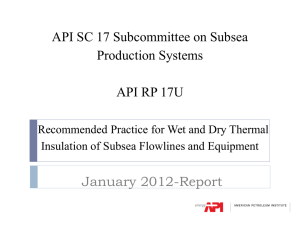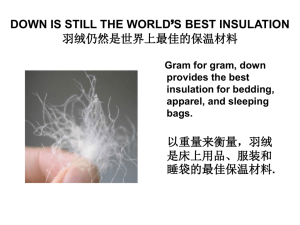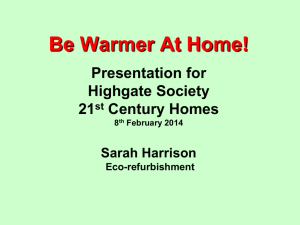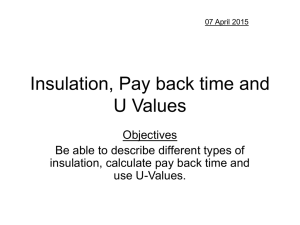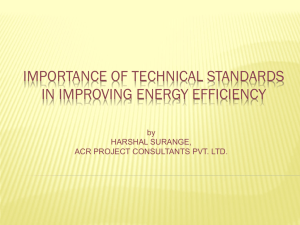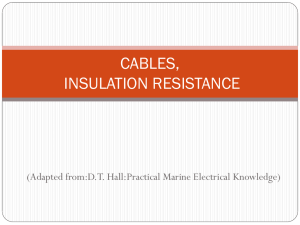Multi-criteria insulation study summary
advertisement
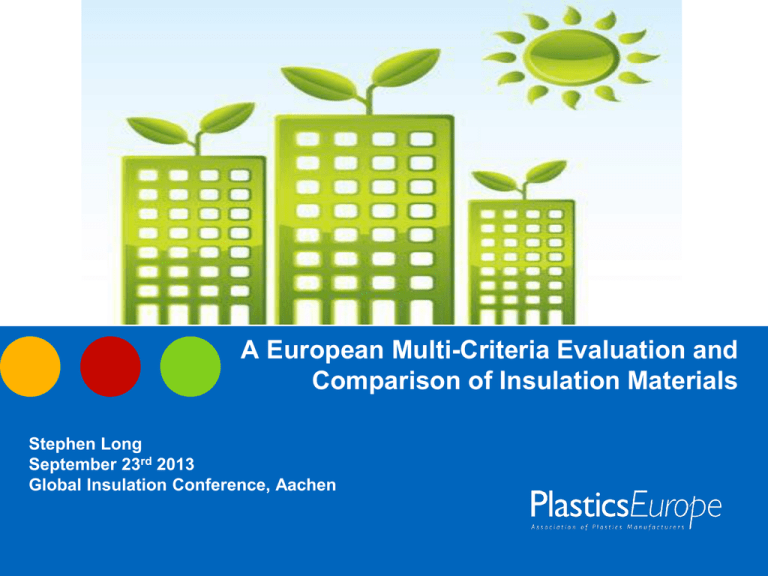
A European Multi-Criteria Evaluation and Comparison of Insulation Materials Stephen Long September 23rd 2013 Global Insulation Conference, Aachen Contents of the presentation • • • • • • • • Background Objectives Scope Methodology Key conclusions Comparative results by application and country Results by type of material Summary 2 Background • Legislation is directed towards the building envelope in terms of assessment of properties and this should be the usual practice. • However, many previous studies have indicated differences in insulation materials and statements continue to be made comparing plastic insulation, mineral insulation and renewable insulation materials. • This study attempts to give a more thorough, objective basis for such comparisons. • PlasticsEurope contacted the Büro für Umweltchemie in Zurich to carry out this new study Objectives and use of the study • The purpose of the study was to develop a multi-criteria evaluation and comparison of different thermal insulation materials in Europe • The result is an assessment of the contribution to sustainability, as well as a guide to the advantages and weaknesses of these materials used in buildings • The study makes a contribution to the ongoing discussion about how to take into account the sustainability-related performance of products • The report should be seen as an opportunity to stimulate thoughts and as an invitation for stakeholders to add their contributions in order to progress further 4 Scope • Comparative assessment of the most important insulation materials in their building applications using Germany, Italy and Sweden as reference countries • No results for Sweden however due to difficulties in obtaining reliable information on specific applications and materials used • Covers all typical insulation applications, and the most common insulation materials used for these applications • More than 300 insulation products analysed: 5 Evaluated products/applications Material Germany Italy Sweden Total Stone wool 33 17 10 61 Glass wool 25 16 15 54 EPS Standard 44 17 21 82 Grey EPS 9 12 1 21 XPS 12 18 18 33 PUR/PIR 24 13 5 40 Foam glass 4 4 4 Natural fibres 11 3 1 16 Aerogel materials 3 2 2 4 164 98 77 316 Total in flat roof, pitched roof, ventilated facade, ETICS and perimeter applications Methodology (1) • The comparison is made on products having the same insulation performance: It is methodologically essential to compare insulation materials taking the final application in the building into account. This is achieved by an assessment on the basis of the same performance (U-value) for a given application, including all necessary measures to fix and protect the material. This approach should be a prerequisite for all comparative sustainability considerations of insulation materials and is now also required by the European standardization of sustainable construction assessments meanwhile developed in CEN TC 350. Results can be different compared to a mass or volume based approach. 7 Methodology (2) - LCA • An important part of the findings are based on data from Environment Product Declarations according to ISO 14025 • Although these EPDs are based on the same standard and are third party verified, comparability might be limited because of different units taken into account and other methodological differences • More harmonized approaches will be needed in the future • Data from Eco-Invent used in the absence of EPD 8 Methodology (3) – hazard versus risk • The most important additives with hazard classifications commonly used in insulation materials discussed in general • Simplified risk assessment undertaken, based on physical properties and eco-toxicological parameters • Due to lack of consistent exposure data, assumptions made on exposure probabilities • Methodology described in Saling/Landsiedel 2005 • Information on intrinsic hazards connected with projections on exposure based on • production volume, • wide use of a substance in many applications • possible exposure routes • It is assumed that these indicators allow for a projection of exposure probabilities with sufficient exactness, while it is not claimed that these assumptions create an accurate picture of reality • This aspect clearly requires further methodology developments to take exposure into account more accurately 9 Representation of the results • Spider diagrams used to represent the criteria in a consistent, graphical way • The selection of the criteria (axes) represents the whole life cycle including all aspects that are important according to common practice and standards • The axes indicate the extreme values for a given application. Therefore it is not possible to compare insulation materials from one application to another. • The larger the number, the better the property, i.e. the larger the shaded enclosed area in a spider diagram, the “better” the overall assessment 10 Spider diagram Coverage of the life cycle stages 12 Explanation of axes’ criteria 13 Key conclusions 1. 2. 3. 4. All insulation materials, including the impact of necessary constructions and adaptations of the building, have an overall positive effect on the sustainability of a building calculated over its lifecycle There is no single material that is best in all applications. Results depends significantly on the application and construction The performance of natural based materials is not necessarily better than plastics or minerals The climate region has only a minor effect on the results 14 The results • The most common applications and materials on the market today have been assessed for Germany and Italy. Hence certain applications or materials such as spray foam or sandwich panels that might be more relevant in other countries are not covered in this study. • For Germany, five main insulation applications on roofs and walls have been identified. • In Italy two wall and two roof applications have been selected. • One spider diagram presents the results for one insulation material in a given application area. • The graphic presentation of the results includes more than fifty spiders in nine application areas. Comparative results for flat roofs Germany Italy 16 Comparative results for pitched roofs Germany Italy 17 Comparative results for ventilated façade Germany Italy 18 Comparative results for ETICS Germany Italy 19 Comparative results for perimeter (Germany only) 20 Results by type of material (1) • General statements based on this comparative study are not possible • Products of the same insulation material in different applications can be very different in terms of density and thermal conductivity • In consequence the results for one given material vary from one application to another • The spider concept does not allow comparisons between different applications since the scales of axes are different 21 Results by type of material (2) • Mineral fibre products • Glass wool has in general more advantages than stone wool. Glass wool is best in most of the production aspects with the application of ventilated façades and pitched roof (between rafters) • Currently produced mineral fibres have no hazardous potential except for dust, but adequate workers’ protection can deal with the related exposure risk. However there is hardly any recovery potential with mineral fibres • Foam glass • Two common applications of foam glass are compact flat roof and slabs fixed to the perimeter wall. There is no potential risk of exposure to hazardous substances. Its summer smog potential is the lowest in both applications. All other indicators were worse compared to the alternatives. Results by type of material (3) • EPS is strong with three production LCIA indicators in the applications flat roof, ETICS and perimeter • Investment costs lowest within these applications. The grey type is always more favourable than white EPS. The production LCIA indicator for the photochemical ozone creation potential (POCP) is normally worse in comparison to other materials; the reason is the use of pentane as a blowing agent that contributes to ground-level ozone creation when released from the foams. • XPS has been proposed for perimeter, flat and pitched roof (over rafters) applications • Environmental performance is similar to EPS but with differences derived from different surface weights and a lower summer smog potential (POCP) 23 Results by type of material (4) • PUR/PIR is always best in terms of thickness per functional unit. • In the flat roof and ETICS application the aspects of sustainability are comparable to EPS standard • A much lower recovery potential is accompanied by lower summer smog potential • Its potential risk is the lowest among plastic foams and comparable to mineral materials. Results by type of material (5) • Natural fibre products have been analysed for the ventilated façade (hemp fibre in Germany, flax fibre in Italy) and ETICS (wood fibre in Germany) applications • The advantages of natural fibres are enhanced recovery potential and low potential risk • The main disadvantage is a usually higher lambda value with relatively high densities • Hemp and flax fibre slabs in the ventilated façade have advantages in climate friendliness, application suitability and the low potential risk • Wood fibre slabs in the ETICS application have high densities. Their LCIA indicators for production are worse than plastic foam solutions. 25 High level summary • Plastic foams show superior performance in flat roof, pitched roof over rafters and ETICS • Density and thermal conductivity are usually lower for plastics foams compared to mineral fibres. The higher tensile strength and the lower water absorption of plastic foams are an advantage for many applications. • Natural fibre products do not necessarily have better performance than other insulation materials. • Glass wool has in general more advantages than stone wool. • Mineral fibres are favourable regarding their reaction to fire without any flame retardants and their negligible thermal expansion properties. Other comments • A proper construction is a basic prerequisite for a long use period without damage. It means appropriate fixing of the insulation, an efficient protection from the influence of weather, sufficient tensile strength for the related loads and measures to avoid condensed water and thermal bridges. • LCIA data from ecoinvent, Ökobau.dat and the available EPD’s vary significantly. • Continuing need to improve risk assessment methodology • Inclusion of gate to grave assessments and associated methodology
